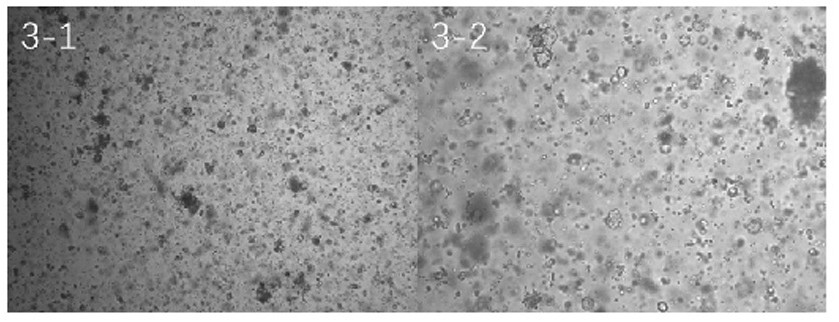Construction method of human pancreatic cancer tissue organoid model
A construction method and pancreatic cancer technology, applied in the field of biomedicine, can solve the problems of insufficient density of pancreatic cancer organoids, hindering the early development of clinical drug screening, and difficult separation of pancreatic cancer cells, achieving low cost, high success rate, Applicable effect
- Summary
- Abstract
- Description
- Claims
- Application Information
AI Technical Summary
Problems solved by technology
Method used
Image
Examples
Embodiment 1
[0071] A method for constructing a human pancreatic cancer tissue organoid model, comprising the following steps:
[0072] Step S1: Rinse the fresh human pancreatic cancer specimen with washing solution, and shred it mechanically;
[0073] Specifically, transfer the human pancreatic cancer specimens into a 15 mL centrifuge tube, shake and wash with 5 mL of pre-cooled cleaning solution for 30 seconds, discard the supernatant, add 5 mL of pre-cooled cleaning solution for washing again, and repeat 3 times. Then in a pre-cooled 1.5mL EP tube, cut the specimen to 1mm with direct shears that have been autoclaved 3 For left and right tissue fragments, resuspend the tissue fragments with pre-cooled basal medium, pipette the supernatant into a pre-cooled 15mL centrifuge tube, and resuspend 3 times;
[0074] Filter the supernatant obtained three times through a 100 μm filter, and then filter the obtained filtrate through a 20 μm filter to obtain a filter residue, which is resuspended w...
Embodiment 2
[0087] A method for constructing a human pancreatic cancer tissue organoid model differs from Example 1 in that the enzyme digestion solution used in Example 2 contains 2.5 mg / mL collagenase II, 100 μg / mL DNase I and 10.5 μM Y- The basic medium of 27632 was shaken and digested for 30 minutes in step S2, and the rest of the steps and sources of pancreatic cancer specimens were the same as those in Example 1.
Embodiment 3
[0089] A method for constructing a human pancreatic cancer tissue organoid model, which differs from Example 1 in that the pancreatic cancer specimens in Example 3 come from different patients, and the matrix material used in Example 3 is ready-to-use without overnight thawing The matrix material used in Example 3 is made by mixing type I collagen, 10×PBS, NaOH solution; the concentration of type I collagen purchased in this embodiment is C I is 3.17 mg / mL; the volume of the matrix material configured in this example is V=511.5 μL; the protein concentration C of the obtained matrix material is 2.79 mg / mL;
[0090] The volume calculation method of type I collagen, 10×PBS, NaOH solution is:
[0091] Volume V of type I collagen I =V×C / C I ;
[0092] 10 x volume V of PBS PBS =V / 10;
[0093] The volume V of 1M NaOH solution NaOH = V I ×0.023;
[0094] According to the above calculation method, 51.15 μL of 10xPBS and 10.35 μL of 1M NaOH solution are required respectively. I...
PUM
 Login to View More
Login to View More Abstract
Description
Claims
Application Information
 Login to View More
Login to View More - R&D
- Intellectual Property
- Life Sciences
- Materials
- Tech Scout
- Unparalleled Data Quality
- Higher Quality Content
- 60% Fewer Hallucinations
Browse by: Latest US Patents, China's latest patents, Technical Efficacy Thesaurus, Application Domain, Technology Topic, Popular Technical Reports.
© 2025 PatSnap. All rights reserved.Legal|Privacy policy|Modern Slavery Act Transparency Statement|Sitemap|About US| Contact US: help@patsnap.com



